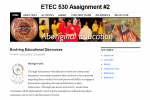Knowledge Building (ETEC 530)
 Constructivist Strategies for E-Learning (elective course)
Constructivist Strategies for E-Learning (elective course)
This course provided the opportunity to examine teaching that aims to better understand teaching and learning. Through current research and practice on contemporary constructivist instructional strategies I examined my personal beliefs and worldviews about the nature of knowledge and truths, and how these impact or influence my pedagogy of teaching and learning. Key instructional approaches and methods including project-based teaching/learning and cooperative learning were critically discussed. The principles employed in these strategies were considered and applied to practical experiences of designing and delivering online instructions.
Connections to Pioneer Life
Early pioneers had to take every opportunity to learn lessons that would keep them fed and safe, they had to to examine their past practice and come to grips with the usefulness of that knowledge along their journey. They had to be entrepreneurs, explorers, and creators as they were faced with many challenges through which they had to build on background knowledge and construct new knowledge and/or learn to do new things in new ways.
Written Artifacts
Artifact 1: A Review and Update of Jonassen’s (1998) Model of an Online Constructivist Learning Environment
Artifact 2: Lesson Plan (Math 10) Final Group Response
Artifact 3: A Lesson on Discourse Regarding Aboriginal Education Utilizing the Principles of CIM, POE and CCM
Artifact 4: SET CRITERIA with Station Summaries
Technology Artifacts
Artifact 5: Link to Constructivist On-Line Lesson on Aboriginal Education
General Reflection:
My favourite artifact from this class is the online lesson on Aboriginal education. I will admit that I got a little carried away with developing this lesson and series of activities and probably went a little deeper than was necessary – but the personal constructivist learning was outstanding! I really enjoyed this type of assignment because I got to create an online learning environment!
Next, I am delighted to have discovered the wealth of information, free for use for educational purposes, developed by the First Nations Program at UBC (Crey & Perreault, 2008). I have used much of their content in this online lesson development. They are credited in the reference section and in a few other places throughout.
I am also very fortunate to have located the opensource software associated with ProBoard for creating the online discussion forms used extensively in the lesson activities. The lesson is housed within the UBC Blogs.
The lesson framework that I used was greatly adapted from one that I created for the course that I taught last summer in special education at the local university. The reason I included it in that summer course is because of the over-representation of Aboriginal students in four of the Ministry of Education special needs categories. I turned the originally intended “brief” discussion into a “full day of inquiry” about our beliefs and attitudes regarding Aboriginal Education and why we must ensure that no students are wrongly placed in special education due to cultural, linguistic or other diversity-based reasons. It was an eye-opening experience for me to host such a discussion as a non-Aboriginal. I was expertly guided in my preparation by the District Principal for Aboriginal Education from School District 68 (Nanaimo-Ladysmith), Ms. Laura Tait. I want to extend a sincere appreciation to Ms. Tait for the encouragement she gave me to take on this lesson content despite my initial apprehension. I accepted the challenge to “pry open” the long-held assumptions that sometimes go unchallenged in our discussions.
In using the content created by Crey & Perreault (2008) I developed what I believe to be a truly constructivist lesson based on the three models that we had focused on in the course; namely the constructivist principles of the CIM, POE and CCM models. The charts included in the Blog lesson section titled “Constructivism” identify the activities that align with each specific model.
The initial activity to kick off the lesson is a personal brainstorming session for each student on their background knowledge of Aboriginal Education. They are to create a concept map and maintain it throughout the course. The online lesson gives them the details and also the link to download CMAP. This online concept map is easily modified by the students as they brainstorm, then through reflection as they complete activities and make changes again due to discussion forum activities and more reflection as they challenge their assumptions.
In the next activity I wanted the students to contemplate their personal views and prior knowledge using a wonderful essay by Marie Battiste as the impetus for reflection. I wanted the students to contemplate, in private, their own possible Euro-centric views and have them reflect on what they could do to blatantly explore this Euro-centrism in terms of guiding student conversations in their classrooms.
Once online in activities two – eight I would encourage students to probe their beliefs and ideas about Aboriginal education, over-representation in some special needs categories and our own wide-spread Euro-centric views that we, most times unknowingly, bring with us into the classroom.
In the eight activities that I have created there are many opportunities for students to make predictions about what is behind the actions of individuals in the video. Then, through the online discussion forums, the students will have opportunities to change and/or modify their ideas/conclusions and also to build upon them in relation to the lesson objectives.
The Constructivist Instructional Model (CIM) provides the best fit for this lesson series, however, all three models have been utilized and incorporated. The CIM model is initiated with the search through the student’s background knowledge and thorough exploration of their content knowledge and beliefs on Aboriginal education. Then, as in the other two models, predictions are made and new learning is constructed through the personal and peer challenges, and reflection.
The Prediction, Observation and Explanation Model (POE) provides students with the ability to observe a situation and make predictions as to how to best guide the discussion and/or solve the issue. They can then test their predictions in their own minds as they watch the video segments and then discuss their predictions with their peers online. They can then practice their new learning online with their peers in preparation for the “real life” discussions they will have in their own classrooms in the future.
The Conceptual Change Model (CCM) indicates that new knowledge construction results from connections with pre-existing ideas/information. As students are invited to investigate and challenge their beliefs through the activities they will discuss their dissatisfaction and enter into generating new meaning. In this way the topic becomes immediately meaningful, challenges their predictions or initial ideas, and because the discussion forums provide students with the ability to exchange their ideas, it provides authenticity to the discourse and as such, greater meaning and new learning.
This was a fantastic exercise and it was truly a learning experience. Due to the work and effort that went in to creating this series of online lesson activities, I am looking forward to using it in the future in my university teaching. I will also share this lesson with Ms. Tait in Aboriginal Education to determine if it can be useful to her in her work.
Reflecting toward the future:
What do I see as the supports that would help me to further cultivate my practice of pioneering leadership?
- I would like to team-up with a colleague and implement some of the learning from this course as it was one of the most practical “theory to practice” courses that I have ever taken. I am keenly interested in PBL and will see out opportunities to implement this practice.
How does theory learned in this course offer me insights about how I might nurture a change in the culture of my community?
- I have been working with colleagues both within the school district and with community agencies to create a “Day Treatment Program” that would be specific to children who have mental health issues that create barriers to their learning in a traditional setting. Many of the theories learned in this course are widely applicable to the design and engagement necessary to meet the needs of the aforementioned student population.
Implementation, surprises, and consequences? Regrets?
- I shouldn’t be surprised but the learning from this course has stayed with me ever since. I have learned so much about the constructivist learning theories and how I can apply them in the creation of an online lesson that I’ve used my new knowledge again and again.
- The consequences have only been positive in that my students were always engaged.
- No regrets.
How does these projects affect your practice or what new perspectives have you discovered in reflection?
- These projects have been so engaging and purposeful that the practical learning fit my learning style perfectly. This learning has become part of my DNA. 🙂
Next Steps:
- I will continue to utilize this learning in all lessons/courses that I create.
| Pioneer Trail | ||||
| Bullet Trail |


